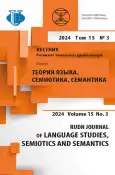Synharmonic Phonostylistics in Comparison with Non-Synharmonic one: on the material of the Kazakh and Russian Languages
- Authors: Dzhusupov M.1, Saparova N.1
-
Affiliations:
- Uzbek State World Languages University
- Issue: Vol 15, No 3 (2024)
- Pages: 895-913
- Section: FUNCTIONAL SEMANTICS, GRAMMAR AND STYLISTICS
- URL: https://journal-vniispk.ru/2313-2299/article/view/323592
- DOI: https://doi.org/10.22363/2313-2299-2024-15-3-895-913
- EDN: https://elibrary.ru/IHPGUH
- ID: 323592
Cite item
Full Text
Abstract
As a scientific discipline phono stylistics originates from the scientific studies by N.S. Trubetskoy. In the Turkic languages, phono stylistics is synharmonic. The words of the Turkic languages are marked with one of the four types of synharmonism - synharmolingvohard, synharmolingvosoft, synharmolingvolabiohard, siyharmolingvolabiosoft. Synharmonism is a universal prosodic property of the Turkic languages, it permeates the entire word, both monosyllabic and polysyllabic, therefore, phono variations are synharmonic: when alternating phonemes in synharmonic phono variants, another synharmonious phoneme functions in the place of synharmohard phoneme, and another synharmosoft phoneme functions in the place of synharmosoft phoneme. Synharmonism covers both segmental and supersegmental phono stylistics of the Turkic languages. The synharmonic phono stylistics of the Kazakh language is synharmolingual, since labial synharmonism is not manifested in it, with the exception of several words in which the presence of labial synharmonism is debatable. The article is devoted to the study of relevant issues in the field of phono stylistics on the basis of vocabulary of synharmonic and accent languages. The phono variations of the Kazakh language at the prosodic (synharmonic) level are characterized by the following differentiation: into stylistically equivalent singharmonic phono variants; into stylistically not equivalent synharmonic phono variants; into synharmonic phono variants, the sound of which, depending on type of synharmonism, is spelled differently, but in status of normative spelling. In this case synharmonic phono variants of one word can be spelled differently. The polysemy in the manifestation of sound stylistics is based on the typological diversity of languages possessing different systems. Thus, in Russian, the prosodic dominant of a word is verbal stress, heterogeneity and mobility of which contributes to generation of supersegmental phono stylistics of language unit. A change in pronunciation of a word of synharmonic type contributes to the generation of its synharmonic phono variant. This diversity of systems is the basis for heterogeneous manifestation of both segmental and super-segmental phono stylistics in these languages. In course of conducting scientific study, such methods of scientific research as comparative, contrastive, opposition of minimal pairs, semantic-stylistic were used. The results of contrastive study are of theoretical and practical importance.
About the authors
Mahanbet Dzhusupov
Uzbek State World Languages University
Author for correspondence.
Email: mah.dzhusupov@mail.ru
ORCID iD: 0000-0002-2934-2333
SPIN-code: 4302-8351
Scopus Author ID: 57208146546
Dr.Sc. In Philology (Advanced Doctorate), Professor, Professor of the Department of the Modern Russian language
21a, G9a, Kichik halka yuli str., Tashkent, Republic of Uzbekistan, 100138Nurjamal Saparova
Uzbek State World Languages University
Email: saparovanurjamal1974@mail.ru
PhD in Pedagogical Sciences, Senior Lecturer of the Department of the Modern Russian language 21a, G9a, Kichik halka yuli str., Tashkent, Republic of Uzbekistan, 100138
References
- Nurahmetov, E.N. (1997). Problems of suprasegmental phonostylistics (based on the material of the French language) [dissertation]. Moscow. (In Russ.).
- Dzhusupov, M. & Saparova, K.O. (2011). Turkic phonostylistics (based on the material of the Uzbek language). Astana: Saryarqa. (In Russ.).
- Dzhusupov M., Markunas, A. & Saparova, K.O. (2006). Modern Russian language. Phonostylistics. Poznań: Uniwersity Im Adama Mickiewisza w Poznaniu. (In Russ.).
- Saparova, K.O. (2006). Phonostylistics of Russian and Uzbek languages. Tashkent: Uzbekiston. (In Russ.).
- Isaeva, Zh.A. (2000). Phonostylistics of segmented units in the modern Kazakh language (based on changes in sounds in the composition of words) [dissertation]. Almaty. (In Kazakh).
- Prohvatilova, O.A. (1996). Phonostylistics: stylistic analysis of sounding speech. Volgograd. (In Russ.).
- Veshchikova, I.A. (2003). Phonetics of functional styles. In: Stylistic encyclopedic dictionary of the Russian language, M.N. Kozhina (Ed.). Moscow: Flinta, Nauka. pp. 570–572. (In Russ.).
- Danilevskaya, N.V. (2003). Stylistic functions of speech varieties. In: Stylistic encyclopedic dictionary. Moscow: Flinta, Nauka. pp. 401–403. (In Russ.).
- Stepanov, Yu.S. (2000). Style. In: Big encyclopedic dictionary. Linguistics. Moscow: Bol’shaya Rossijskaya enciklopediya publ. pp. 494–495. (In Russ.).
- Dzhusupov, N.M. (2019). Cognitive Stylistics: Theory and practice of the promotion strategy in a literary text. Tashkent: VneshInvestProm. (In Russ.).
- Dzhusupov, N.M. (2019). Cognitive structures through the prism of advancing stable images in an English-language literary text. In: Phraseology in the linguistic picture of the world: cognitive-pragmatic registers: proceedings of the 4th International Scientific Conference on Cognitive Phraseology. Belgorod: Epicenter LLC. pp. 33–35. (In Russ.).
- Zhunisbek, A. (2018). Synharmology or unknown synharmonism. Almaty: Abzal-Aj. (In Russ.).
- Bajtursynov, A. (1992). Language training (works related to the Kazakh language and education). Almaty: Ana tili. (In Kazakh).
- Trubeckoy, N.S. (1960). Fundamentals of phonology. Moscow: Foreign Languages Publ. (Soviet Union). (In Russ.).
- Vekshin, G.V. (2005). To the phonostylistics of the generation of the text (Poems by A.S. Pushkin). Philological Sciences. Scientific Essays of Higher Education, 6, 22–31. (In Russ.).
- Kolenchuk, M.L., Kasatkin, L.L. & Kasatkina, R.F. (2018). A large orthoepical dictionary of the Russian language. Moscow: AST Press Shkola. (In Russ.).
- Temirgazina, Z.K. & Zhakupova, G.K. (2021). Harmony and Disharmony: Acoustic Opposition in the early lyrics of Alexander Blok. RUDN Journal оf Language Studies, Semiotics аnd Semantics, 13(4), 137–152. https://doi.org/10.22363/2313-2299-2021-12-1137-152 (In Russ.).
- Baimukhametova, K.I., Galeeva, T.I., Kaziakhmedova, S.Kh. & Yanova, E.A. (2019). Phonostylistic linguistic means as a means of sound organization of English and Russian literary text. Bulletin of Udmurt University. Series History and Philology, 3, 447–460. https:// doi.org/10.35634/2412-9534-2019-29-3-447-460 (In Russ.).
- Dzhusupov, M. (2022). The transition from Cyrillic to Latin and the problem of linguographic interference in the Russian speech of the Turkophone. Russian Language Studies, 20(3), 312– 329. https://doi.org/10.22363/2618-8163-2022-20-3-312-329 (In Russ.).
- Chilingaryan, K.P. (2021). Corpus Linguistics: VS methodology. RUDN Journal оf Language Studies, Semiotics аnd Semantics, 12(1), 196–218. https://doi.org/10.22363/2313-2299-202112-1-196-218 (In Russ.).
Supplementary files









